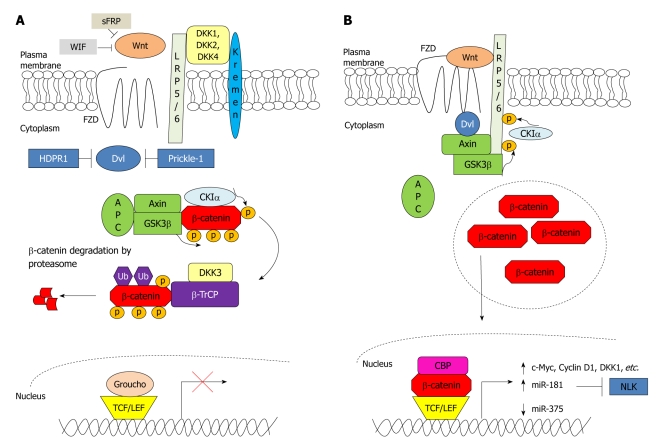Figure 1.
Wnt/β-catenin signalling in the absence and presence of Wnt stimulus. A: Wnt/β-catenin signalling is regulated by several antagonists to prevent the formation of frizzled (FZD)-Wnt-low-density lipoprotein receptor-related protein 5/6 (LRP5/6) complex. Secreted frizzled-related protein (sFRP) and Wnt inhibitory factor (WIF) bind directly to Wnt, whereas dickkopfs (DKKs) bind to LRP5/6. Furthermore, human homologue of Dapper (HDPR1) and Prickle-1 inhibit the action of dishevelled (Dvl). In the absence of Wnt stimulus, β-catenin is first primed for phosphorylation by casein kinase Iα (CKIα) followed by phosphorylation by glycogen synthase kinase 3β (GSK3β) at three residues. The phosphorylated β-catenin is targeted for ubiquitination by β-transducin repeat-containing protein (β-TrCP) and is subsequently degraded by the proteasome. In the nucleus, T-cell factor (TCF)/lymphoid enhancer factor (LEF) represses transcription of the Wnt/β-catenin pathway target genes by interacting with co-repressor Groucho; B: Wnt binds to and activates FZD and LRP5/6 receptors. Dvl is recruited to the plasma membrane and binds to FZD. This results in the recruitment of Axin and GSK3β to LRP5/6. LRP5/6 is then phosphorylated by CKIα and GSK3β, resulting in an inactivation of the destruction complex and leading to β-catenin accumulation in the cytoplasm. β-catenin then subsequently translocates to the nucleus where it binds with TCF/LEF and other co-activators e.g. CREB binding protein (CBP) to mediate transcription of genes and microRNAs responsible for proliferation and growth. APC: Adenomatous polyposis coli; NLK: Nemo-like kinase; p: Phosphorylated; Ub: Ubiquitinated.

